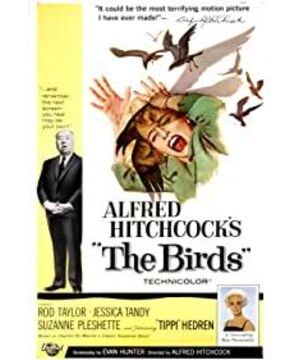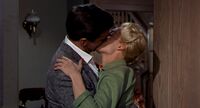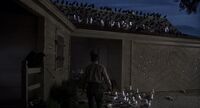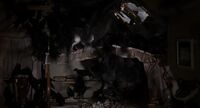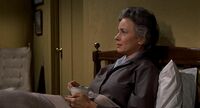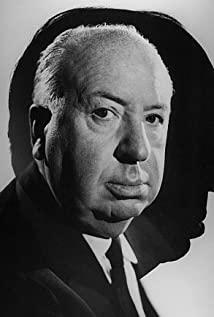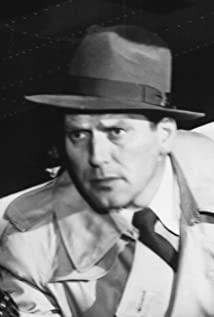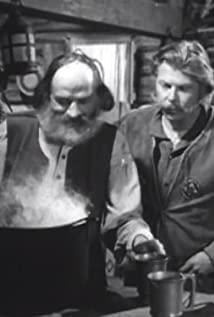And Hitchcock's "Flock of Birds", which I want to analyze today, is regarded as a standard by fans of psychological disaster films. First of all, Hitchcock’s suspenseful trader, coupled with the mantle of disaster films, coupled with the psychological Oedipus complex, and political post-war metaphors, give the disaster revelation meaning of "The Birds" and take the initiative to participate. Enlightenment means more and more pressing.
The plot of "Flock of Birds" abandons Hitchcock’s familiar dangers, with twists and turns. Instead, it adopts a simple story line: the lady Milani of the upper class of San Francisco and the lawyer Mitch fell in love at first sight in a bird shop, when they were in love. When blocked by Mitch's mother, seagulls and sparrows continued to fly near Mitch's home to attack humans, and even caused a fire at the gas station. Milani bravely protected her little sister from bird attacks, and finally won the love of Mitch’s mother. This kind of story clues are simple and clear. The focus of fear is fixed on natural forces instead of human factors. This is different from Hitchcock’s previous suspense mode in the structure of the story. It has therefore become an atypical Hitchcock movie.
In terms of the audio-visual language of the movie, Hitchcock took up his own housekeeping skills. After all, in 1963, when the filming of "The Birds" started, audio-visual elements were used to accelerate the audience’s instinctive expectations for danger and disaster. It is already a unique label of Hitchcock's image style.
In terms of scene scheduling, Hitchcock did not make the lights faintly sway in the dark in the disaster theme and doomsday metaphors. On the contrary, the film's tone and light use are biased towards warm colors, bright, and give people joy and comfort, even in the heroine. In the highlight link of Milani, strong main light and supplementary light are given. The diffuse lighting and half-body lighting make Milani’s identity manifest in the language of light: a lady, pampered, generous and noble, always romantically encountering men. Rich girl. Fellini said: "Light is everything, it can express ideology, emotion, color, depth, style. It can cover up, narrate and describe. If the light is hit right, ugly or silly expressions can be beautiful or intelligent. The light comes.” The large-scale low-contrast lighting in the first half of the movie suggests that the wasteful waiting for the late World War II is finally on the right track of prosperity, but the subsequent panic caused by the bird disaster is like the US-Soviet Cold War. Become a roundabout kick in the history of thriving peace. The light green skirt that the heroine wore after coming to the town of Podga Bay is also an invisible symbol of environmentalism and naturalism, but this symbol happens to be a mockery because she always puts on the light green skirt. A plush coat, in the face of the so-called environmentalist naturalism, but humans always "hold the red flag against the red flag", while advocating the inexhaustible absurdity, while ridiculously exhausting things like a speculative broker The criteria used are effective to the end. Therefore, even seagulls and sparrows, which symbolize peace and beauty, are like crows crowing, giving people a violent panic of disasters coming from the sky and bad people coming. This kind of panic is especially different in the performance of actors. For example, the heroine Milani, her panic is more manifested in the fear of the unknown. This kind of fear is not accompanied by too much life experience or past shadows. For the mother of the protagonist Mitch, an old woman whose husband died not long ago was afraid that a young and beautiful woman would take her son, her fear is not as pure as Milani. It is said that Hitchcock always uses Freud's psychoanalysis in a simple way, and this psychoanalytic element in "The Birds" is very obvious: Freud has touched both life hindrance and destructive behavior The relationship between the problems. Freud discovered in his later years that in addition to sexual impulses and self-defense impulses, there is a propensity for destruction, which is also a motivation in human behavior. As long as we pay a little attention to the relationship between people in society, we will see a lot of destruction. "Most sabotage phenomena are not regarded as sabotage by people. On the contrary, people use various methods to rationalize these sabotage behaviors. People often use words like love, responsibility, conscience, patriotism, etc. to cover up their sabotage. Behavior. Vandalism is an attempt to escape intolerable He is powerless, because his purpose is to eradicate all the objects that he must match. In the case of isolation and powerlessness, anxiety and frustration arise in life. The propensity to destroy is the most common response to this kind of anxiety. Sometimes this threat comes from someone. In this case, the vandalism will target such people. Sometimes, due to the constant feeling of being threatened by the outside world, a lasting anxiety may also arise. "The destructive effect of Mitch’s mother on Mitch and Milani is more prominent in the identity setting of the dead husband: using love and responsibility as an excuse, anxiety and isolation as the basis, it produces destructive frustration under the mother’s performance. The most noticeable, her blue empty expression is always full of suspiciousness, and she is always brewing an instinctive desire that seems to be clear and righteous, but "the heart always wants to make a stumbling child" through her staring eyes Qi. Zeke said in "If you dare to ask Hitchcock, just ask Lacan": "All that Hitchcock did in his films was to rely on performance to maximize the exposure of the crime. The gaze function that comes out. As Godard observed with Hitchcock-it is the gaze that creates the fiction. "
In terms of mirror movement, many positive and negative dialogues use internal reversal. This kind of subjective shots that are not shoulders obviously alienate the relationship between the two in the dialogue. In this film, Hitchcock’s treatment emphasizes Milani’s With the identity of "outsider", she came to the town and brought disasters immediately. Although this is not logically in the same line, Milani is a coincidence inducement of time value in the face of sudden disasters. She is the same as disasters. People keep a distance from the environment. When Milani was avoiding bird attacks in the phone booth, the relationship between humans and animals was inverted. Pets that were previously kept in cages now become attackers, and people are kept in larger "cages" (phone booths). Birds Lei's dive exaggerated the aggressiveness from the angle of the upside-down shot. This dislocation on the props restores the cocoon and self-restraint of human beings. The camera position of this viewing angle allows humans to show the embarrassment of being trapped and encircled.
In terms of editing, the use of cuts has greatly improved the efficiency of suspense. At the 84th minute of the movie, Milani, Mitch, and the captain stood by the restaurant window and talked. When she turned and walked to the window to look out, the camera panned to the right and received a viewpoint lens, a panoramic view, and a docking gas station. At the telephone booth, the birds were ready to go, and then cut to the close-up on Milani's side. The captain entered and blocked the bartender. Then Mitch also entered the camera, occupying the foreground of the picture. All three of them looked sideways out of the window. Each of these four shots has time space and screen content. Hitchcock can of course be done without editing. Just imagine that Renoir can take the shot to the end under the same circumstances, so that no matter how fast the camera is, it won't have a sudden sense of switching due to the cutting editing method. In addition, if you consider deep focus composition, Orson Wells can also explain the scene in one shot, but without the switching of time and space and the position of the characters.
In terms of the use of sound, Hitchcock gave birds a lot of space in "The Birds". Unlike other Hitchcock movies, the soundtrack is used to prelude and kick off the horror. On the contrary, in the film except There is no non-dramatic sound like the birds crying like a mourning hung. The movie starts with the sounds of birds and ends with the sounds of birds. It guides our attention to specific images with the greatest strength, creates a different kind of expectation through natural sound, and also gives new value of silence.
As the strange originator of disaster films, "The Birds" fully conforms to the prying impulse of future generations to disasters and tragedies, which is also inseparable from the audiovisual language. After all, any simple, naked, unfiltered and unselected original revealing of the original appearance has never constituted "suspense" and "fear", but just a pile of "crude" and "chaotic behavior".
View more about The Birds reviews


